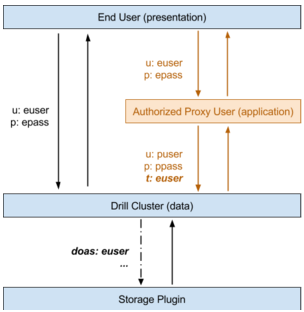Configuring Inbound Impersonation
Drill supports user impersonation where queries run as the user that created a connection. However, this user is not necessarily the end user who submits the queries. For example, in a classic three-tier architecture, the end user interacts with Tableau Desktop, which communicates with a Tableau Server, which in turn communicates with a Drill cluster. In this scenario, a proxy user creates a connection, and the queries are submitted to Drill by the proxy user on behalf of the end user, and not by the end user directly. In this particular case, the query needs to be run as the end user.
As of Drill 1.6, an administrator can define inbound impersonation policies to impersonate the end user. The proxy user needs to be authorized to submit queries on behalf of the specified end user. Otherwise, any user can impersonate another user. Then, the query runs as the end user, and data authorization is based on this user’s access permissions. Note that without authentication enabled in both communication channels, a user can impersonate any other user.
Drill trusts proxy users to provide the correct end user identity information. Drill does not authenticate the end user. The proxy user (application) is responsible for end user authentication, which is usually enabled.
This image shows how identity is propagated through various layers (with authentication enabled). The flow on the left is Drill with user impersonation enabled, and the flow on the right is Drill with user impersonation and inbound impersonation enabled. t:euser is a property on the connection (u is username, pis password, t is impersonation_target).
Configuring Inbound Impersonation
You must be an administrator to configure inbound impersonation. You can define administrative users through the security.admin.user_groups and security.admin.users options. See Configuration Options.
User impersonation must be enabled before you can configure inbound impersonation.
Complete the following steps to enable inbound impersonation:
-
In
drill-override.conf, set user impersonation to true:{ drill.exec.impersonation.enabled: true, ... } -
Define inbound impersonation policies. For example, the following ALTER SYSTEM statement authorizes: *
puser1to impersonate any user (use * as a wildcard character) *puser2to impersonateeuser1and all users inegroup2* all users inpgroup3to impersonate all users inegroup3ALTER SYSTEM SET `exec.impersonation.inbound_policies`=‘[ { proxy_principals : { users: [“puser1”] }, target_principals: { users: [“*”] } }, { proxy_principals : { users: [“puser2”] }, target_principals: { users: [“euser1”], groups : [“egroup2”] } }, { proxy_principals : { groups: [“pgroup3”] }, target_principals: { groups: [“egroup3”] } } ]’; Policy format: { proxy_principals : { users : [“...”, “...”], groups : [“...”, “...”] }, target_principals: { users : [“...”, “...”], groups : [“...”, “...”] } } -
Ensure that the proxy user (application) passes the username of the impersonation target user to Drill when creating a connection through the
impersonation_targetconnection property. For example, through sqlline:bin/sqlline –u “jdbc:drill:schema=dfs;zk=myclusterzk;impersonation_target=euser1” -n puser1 -p ppass1
In this example, puser1 is the user submitting the queries. This user is authenticated. Since this user is authorized to impersonate any user, queries through the established connection are run as euser1.


